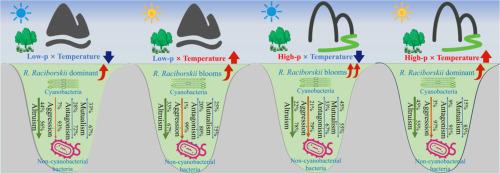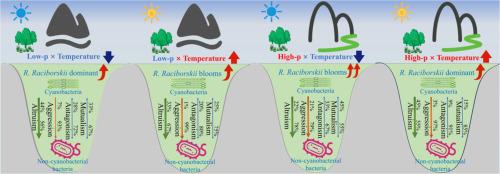The shifts in microbial interactions and gene expression caused by temperature and nutrient loading influence Raphidiopsis raciborskii blooms
IF 11.4
1区 环境科学与生态学
Q1 ENGINEERING, ENVIRONMENTAL
引用次数: 0
Abstract
Climate change and the trophic status of water bodies are important factors in global occurrence of cyanobacterial blooms. The aim of this study was to explore the cyanobacteria‒bacterial interactions that occur during Raphidiopsis raciborskii (R. raciborskii) blooms by conducting microcosm simulation experiments at different temperatures (20 °C and 30 °C) and with different phosphorus concentrations (0.01 mg/L and 1 mg/L) using an ecological model of microbial behavior and by analyzing microbial self-regulatory strategies using weighted gene coexpression network analysis (WGCNA). Three-way ANOVA revealed significant effects of temperature and phosphorus on the growth of R. raciborskii (P < 0.001). The results of a metagenomics-based analysis of bacterioplankton revealed that the synergistic effects of both climate and trophic changes increased the ability of R. raciborskii to compete with other cyanobacteria for dominance in the cyanobacterial community. The antagonistic effects of climate and nutrient changes favored the occurrence of R. raciborskii blooms, especially in eutrophic waters at approximately 20 °C. The species diversity and richness indices differed between the eutrophication treatment group at 20 °C and the other treatment groups. The symbiotic bacterioplankton network revealed the complexity and stability of the symbiotic bacterioplankton network during blooms and identified the roles of key species in the network. The study also revealed a complex pattern of interactions between cyanobacteria and non-cyanobacteria dominated by altruism, as well as the effects of different behavioral patterns on R. raciborskii bloom occurrence. Furthermore, this study revealed self-regulatory strategies that are used by microbes in response to the dual pressures of temperature and nutrient loading. These results provide important insights into the adaptation of microbial communities in freshwater ecosystems to environmental change and provide useful theoretical support for aquatic environmental management and ecological restoration efforts.


温度和营养负荷导致的微生物相互作用和基因表达的变化影响了 Raphidiopsis raciborskii 的繁殖
气候变化和水体的营养状况是全球蓝藻水华发生的重要因素。本研究的目的是利用微生物行为生态模型,在不同温度(20°C 和 30°C)和不同磷浓度(0.01 mg/L 和 1 mg/L)条件下进行微生态模拟实验,并利用加权基因共表达网络分析(WGCNA)分析微生物的自我调节策略,从而探索在 Raphidiopsis raciborskii(R. raciborskii)水华期间蓝藻与细菌之间的相互作用。三因子方差分析显示,温度和磷对 R. raciborskii 的生长有显著影响(P <0.001)。基于元基因组学的浮游细菌分析结果表明,气候和营养盐变化的协同效应增强了 R. raciborskii 与其他蓝藻竞争蓝藻群落优势地位的能力。气候和营养物质变化的拮抗作用有利于 R. raciborskii 藻华的发生,尤其是在约 20°C 的富营养化水域。物种多样性和丰富度指数在 20°C 富营养化处理组与其他处理组之间存在差异。共生浮游细菌网络揭示了水华期间共生浮游细菌网络的复杂性和稳定性,并确定了网络中关键物种的作用。研究还揭示了蓝藻与非蓝藻之间以利他主义为主导的复杂互动模式,以及不同行为模式对 R. raciborskii 藻华发生的影响。此外,这项研究还揭示了微生物在应对温度和营养负荷双重压力时所采用的自我调节策略。这些结果为淡水生态系统中微生物群落适应环境变化提供了重要见解,为水生环境管理和生态恢复工作提供了有益的理论支持。
本文章由计算机程序翻译,如有差异,请以英文原文为准。
求助全文
约1分钟内获得全文
求助全文
来源期刊

Water Research
环境科学-工程:环境
CiteScore
20.80
自引率
9.40%
发文量
1307
审稿时长
38 days
期刊介绍:
Water Research, along with its open access companion journal Water Research X, serves as a platform for publishing original research papers covering various aspects of the science and technology related to the anthropogenic water cycle, water quality, and its management worldwide. The audience targeted by the journal comprises biologists, chemical engineers, chemists, civil engineers, environmental engineers, limnologists, and microbiologists. The scope of the journal include:
•Treatment processes for water and wastewaters (municipal, agricultural, industrial, and on-site treatment), including resource recovery and residuals management;
•Urban hydrology including sewer systems, stormwater management, and green infrastructure;
•Drinking water treatment and distribution;
•Potable and non-potable water reuse;
•Sanitation, public health, and risk assessment;
•Anaerobic digestion, solid and hazardous waste management, including source characterization and the effects and control of leachates and gaseous emissions;
•Contaminants (chemical, microbial, anthropogenic particles such as nanoparticles or microplastics) and related water quality sensing, monitoring, fate, and assessment;
•Anthropogenic impacts on inland, tidal, coastal and urban waters, focusing on surface and ground waters, and point and non-point sources of pollution;
•Environmental restoration, linked to surface water, groundwater and groundwater remediation;
•Analysis of the interfaces between sediments and water, and between water and atmosphere, focusing specifically on anthropogenic impacts;
•Mathematical modelling, systems analysis, machine learning, and beneficial use of big data related to the anthropogenic water cycle;
•Socio-economic, policy, and regulations studies.
 求助内容:
求助内容: 应助结果提醒方式:
应助结果提醒方式:


